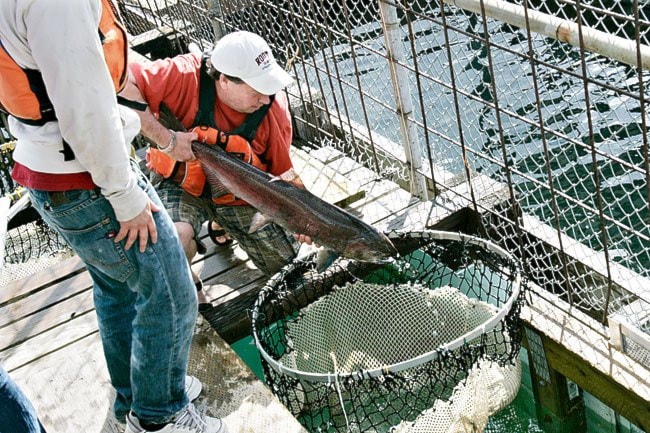Rather than shortchanging the Yukon by 10,000 chinook, it looks like Alaska may be sending a few thousand extra salmon over the border.
The Yukon First Nations chinook fishery is now open, and the commercial, sport and domestic fisheries may not be far behind.
Every year, Alaska is obliged to send about 45,000 chinook across the Canadian border, say the provisions of the Yukon River Salmon Agreement.
As of yesterday afternoon, 51,000 chinook had been counted passing Eagle, Alaska - the last major Alaskan outpost before Canadian waters.
Whitehorse saw its first chinook on Monday afternoon.
Three to four chinook lingered at the bottom of the Whitehorse Fish Ladder yesterday afternoon. By today, they are expected to start making their way towards Schwatka Lake.
For the past three years, Alaska has failed its agreement obligations.
But this year, the Alaska Department of Fish and Game brought unprecedented restrictions against Alaskan fishers.
The Alaskan commercial fishery is closed, and Alaskan subsistence fishers (which includes both native and nonnative fishers) have seen their allowable fishing times cut in half.
Now, with Canadians facing salmon abundance, and Americans reeling from their worst-ever salmon harvest, Alaskan regulators are facing “political strife and controversy,” said Matt Evensen, a researcher with the Sport Fish division of the Alaska Department of Fish and Game.
“The Alaska Department of Fish and Game fucked up, to put it mildly, and so did the federal fisheries managers,” said Myron Naneng, president of the Association of Village Council Presidents, an organization representing 56 native Alaskan tribes.
The tough regulations stripped villagers of needed salmon, and now those regulations appear to have been unnecessary, said Naneng.
Last winter, many salmon-dependent Alaska villages faced crisis situations.
With food stocks at an all-time low, and fuel oil at a premium, villagers were forced to accept emergency food aid from the Alaska government.
“It’s going to be just as bad or worse (this year),” said Naneng.
In late June, six fishers from the village of Marschall, Alaska defied regulations, illegally catching 100 chinook salmon.
“With pending charges against (Marschall fishers), I don’t think what they’re allowing in Canada is acceptable,” said Naneng.
Salmon returns are always hard to forecast, and by the time you know what the year will yield, “the fish have already gone by and it’s too late to do much about it,” said Evensen.
The Alaska sport fishery has continued in 2009. However, since sport fishing is done in Alaskan tributaries of the Yukon River, the fishery does not affect Canadian chinook returns.
The restrictions have created “angst” in Alaska, “but that works both ways; for years there’s been angst in Canada about aggressive harvest policies in Alaska not allowing enough fish to come in,” said Evensen.
For years, Canadian fishers have taken restrictions that “haven’t necessarily been reciprocated in Alaska,” said Yukon commercial salmon fisher Sebastian Jones.
Unable to cast his chinook nets for the past two years, Jones now has a job with Yukon College.
“So to speak, the shoe is on the other foot,” said James McDonald, fish and wildlife director for the Tr’ondek Hwech’in.
The Trondek are “absolutely delighted” the First Nation fishery restrictions were lifted, said McDonald.
For the past decade, Yukon River chinook have been in gradual decline.
Reopening Canadian fisheries at the first sign of a rebound seems to throw a wrench into long-term conservation efforts.
“Conservation of the stock is the highest priority ... that’s one of the things that we’re considering before other decisions are made,” said Frank Quinn, Yukon area director of Fisheries and Oceans.
Strictly speaking, Yukon River salmon populations could be fully restored if they were just left alone for two or three generations, said Jones.
“But, there’s a lot of people that depend upon these fish ... it would destroy a way of life,” he said.
But leaving the salmon alone may not yield as many future salmon as expected.
“You could have a really small escapement that produces a huge return, or you could have a really big escapement that produces a huge return, it’s not always a consistent straight-line relationship,” said Evensen.
As for what’s causing the decline, many Alaskans point the finger at the Bering Sea pollock fishery.
Every year, pollock fishers haul up an average of 80,000 chinook salmon as “bycatch” in their nets.
And until 2011, pollock vessels will not face bycatch restrictions.
“The burden of conservation has been placed primarily on people in the river system,” said Naneng.
The bycatch comprises fish from Russia, BC and Japan - it remains to be seen how many bycaught salmon are Yukon River-bound.
But Alaskan subsistence fishers are not free from blame, say some Yukon fishers.
“There may be this thing about the pollock bycatch, but nobody’s ever mentioned that the subsistence fishery in Alaska is huge,” said Dan McDiarmid, a Yukon domestic fisher.
In 2008, Alaskan subsistence fishers netted 24,400 salmon. Only 63,500 chinook made it into Canadian waters. Of those, Yukon First Nations netted 2,900.
“We need salmon just as much as they do; people that have been dependent on it for most of their life, and some for thousands of years,” said McDiarmid.
If the domestic fishery is reopened, McDiarmid plans to catch about 20 salmon.
What fishers should be doing for conservation, said Jones, is catching smaller salmon.
“When I started fishing in the 1980s, it was very common for us to catch fish of 40, 50, 60, even 70 pounds,” said Jones.
Years of stringing out nets that favour large salmon, however, has severely altered the salmon gene pool, he said.
“By the mid-1990s, it was pretty rare to catch a fish over 40 pounds,” said Jones.
Contact Tristin Hopper at
tristinh@yukon-news.com
